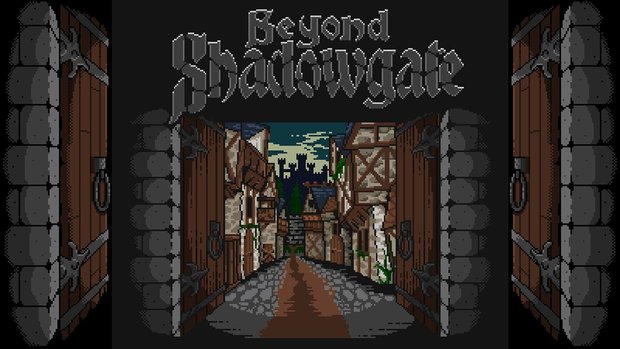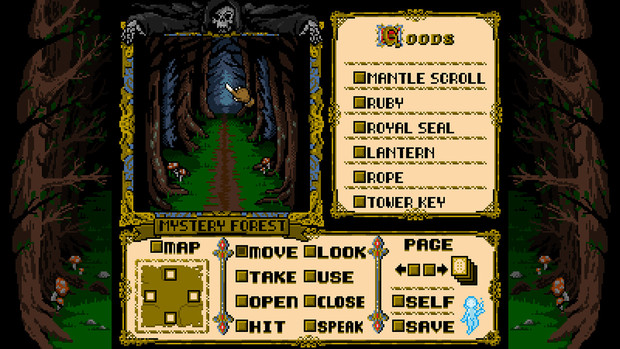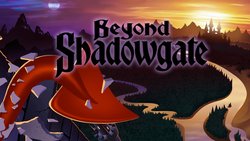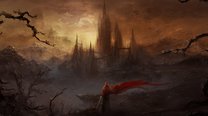Beyond Shadowgate review

- 0 Comments
The “official” sequel ventures out of the legendary castle but never strays far from its nostalgically retro roots
I first played Shadowgate on my Nintendo Entertainment System when I was nine years old and I was hooked immediately. It was my first foray into the horror genre, and I was sucked in by the haunting music, tense situations, and clever puzzles. Today it remains one of my favorite games from my childhood. Beyond Shadowgate (unrelated to the 1993 TurboGrafx CD game of the same name) is the “official” sequel by indie designer Zojoi, a company headed by the same folks who created the original. And unlike Zojoi’s own 2014 Shadowgate remake, it appears to have been made for people like me who adore the classic version. While there are some minor modern conveniences, this follow-up could very well have been released in 1991 as it matches the original in tone and style. In fact, it’s so retro that I sincerely wonder whether Beyond Shadowgate will capture the interest of many outside of its intended audience. Even I would have appreciated a more modern take of this universe, but I still enjoyed bathing for hours in its nostalgia.
Taking place 35 years after Jair defeated the Warlock Lord (which yours truly did...35 years ago), the land of Kal Torlin is once again at risk of falling to dark forces. This time you play as Del Thornburrow, a Fenling who is both shorter and weaker than the higher status humans he lives among. You’re in jail for petty theft (i.e. no good stinkin’ reason), and must escape before finding yourself unwittingly in a quest to save the land while sidestepping monsters, traps, and unseen forces. The king too has been being imprisoned and replaced with an imposter, so with help from the townsfolk to arm yourself and sneak back into the castle, you must discover the inner workings of the evil plot and save him. Just this section – perhaps a quarter of the game at best – is as long as the original game, but there’s much more to come as you will then be sent on a journey through the countryside to track down the bigger players behind this conspiracy, whoever they may be.
Point-and-click gameplay is virtually identical to Beyond Shadowgate’s predecessor. While you can use a gamepad, moving the cursor is much quicker with a mouse. The screen is divided into five frames. In the upper left is a static first-person image of the current area. In the upper right is your unlimited inventory, which is depicted by text. The bottom left is a basic map highlighting room exits. The bottom middle is the verb list, which consists of MOVE, LOOK, TAKE, USE, OPEN, CLOSE, HIT, and SPEAK. The bottom right includes a command to cycle through pages of your inventory, SELF (which can be used as a noun with the above verbs), and the save command. All of these functions also have keyboard shortcuts for those inclined. When the game is providing information to you (such as describing your surroundings or a string of dialogue), the bottom half is overlaid with a page of scrolling text. The only other addition is the image of an ephemeral creature in the lower right corner, who acts as a guide to give you helpful background information. If you click on them, they will provide you with hints that are often so vague their utility is minimal.

Beyond Shadowgate fills the whole screen, but rather than taking advantage of the extra space and enlarging the static image of the current scene, the sides of the screen are adorned with a generic wallpaper background that matches the area you’re in (such as a town, castle, forest, or a house). The pixel art graphics appear 16-bit (think Super Nintendo), but are quite colorful if modestly detailed. Rarely did I not know exactly what I was looking at, and the LOOK function took care of anything I did not. Animation of on-screen characters is rare, such as a spirit flickering or a person making a hammering motion, but is effective when present.
The musical score is somewhat disappointing. Perhaps it’s the wonder of a child’s brain, but I vividly remember every track from the NES release. The MIDI-style music here has the same general rhythms, but often feel incongruent with the events playing out, being usually upbeat even in situations that warrant otherwise. The tracks are certainly pleasant to listen to and don’t detract from the experience, but they don’t add to it either.
Navigating the game world is fairly straightforward. To move you can either click a room exit on the minimap, or click on similar areas in the main view screen. Quite welcome is the ability to LOOK at a room exit, giving you a brief text preview of what to expect should you travel that direction. Holding the space bar will bring up a sketch (represented by simple boxes) of the full map of your current area (that you’ve explored so far). One modern convenience I really wish was here is a fast travel option. There are times when you need to double back over a handful or more screens, and things can get monotonous at times. Moreover, every time you switch screens, a shrill sound, crescendoing and decrescendoing, accompanies the action. The noise is lifted straight from the original game, but it’s one I wish would have hit the cutting room floor. Other sound effects (such as landing a punch or pulling a lever) are more understated and add to the atmosphere.

You can combine the USE command with an item in your inventory before clicking the relevant area in the picture, or simply USE something directly on the environment display. For example, you can USE a key on a door, or you can USE a tablecloth to look underneath it. Alternatively, you can USE items on each other to combine them. While most of the verb list is easy to deduce, there are a few times where OPEN should have worked in addition to USE. To my delight, Del uses the HIT command more frequently than Jair did, and in some fairly clever ways.
You will collect six spells throughout your journey, which will populate in your inventory. You use them the same way you would anything else, clicking on the spell and then on the area of the screen you wish to use it on. Many of the spells are required in multiple capacities, some more obvious than others. For example, one spell is used to recall spirits from the dead and is the source of some of my favorite puzzles. Another spell helps eliminate overgrown foliage, helpful given Del’s meager physical abilities. There’s no penalty for incorrectly using a spell (or any inventory item, for that matter), so you can point and click to your heart’s content.
That’s not to say you can’t make mistakes. There are dozens of ways to die (most of them clued in some way), from losing a “battle” with a dangerous foe, disturbing the wrong spirit, or doing something stupid like trying to jump across a long chasm. However, you are always immediately restored to the previous screen right before your fatal mistake; thus, there is no need to worry about taking a risk or spam saving on every screen. Caution, however: you should still save occasionally, as the game doesn’t do it automatically and you’re just one power surge away from losing a lot of progress. I made the mistake of not saving for my last two hours or so of playtime; when I got one of the game’s four endings, I wanted to circle back and try for some others. It was then I learned a couple hours of replay awaited me.
Probably the most significant change from the original Shadowgate is that you are no longer required to find torches to keep your surroundings lit—you’re often outside anyway—to prevent death. This has been replaced by real-time danger in certain situations. When entering a room where an enemy awaits, the frame of the picture will flash red and you will have a limited time (about five to ten seconds) to either retreat or solve a puzzle before being killed. I have to say, not a fan. Cycling through an inventory quickly while scrambling to figure out a solution just leads to a bunch of repetitive death scenes (where the Grim Reaper mocks you). Thankfully, this feature can be turned off, leaving the puzzles the same, just without the time limit. I did so without regret.

The plot itself is your standard accidental hero saves the world and never really changes. Character development takes a back seat to puzzles, and the script is generally pretty hammy. While some of the dialogue and second-person narration is meant to be silly, some is just plain poorly written. For example, as Del comes across a particularly dangerous situation, he understatedly says, “Ugh...that can’t be good.” Oftentimes the game tells you how you should feel with statements such as: “The thought disturbs you greatly.” Let me feel for myself, narrator!
One of my criticisms of the original Shadowgate is that it couldn’t decide if it wanted to be a horror or a comedy, and the same problem exists here. Both genres can certainly co-exist, but in Beyond Shadowgate it’s as if the reins were held back on both. I chuckled several times, but the game never leans hard into the humor and a week later I already can’t recall any of the jokes. And while several situations suggested tension, I barely felt it (even though the narrator told me I should!). The music rarely felt foreboding, and any hair-raising event was often quickly followed by jarring slapstick.
If the sequel shares some of the flaws of the original, it also shares many of its charms. I can assure you that if you liked the first, you will like this one as well. This is in large part due to the puzzles. While some are almost too easy, many are multi-step mindbenders that require significant investigation and undivided attention to subtle clues. For example, on one occasion you need to make a potion, but doing so (without lucking into the solution) requires a careful reading of various scrolls and manuscripts in the area, then taking that knowledge and deducing the solution by improvising with the tools at your disposal. A few red herrings exist to keep things interesting, and there’s no way to lock yourself out of victory (though you can lock yourself out of the best ending at one point).
About halfway through my ten-hour playtime I was feeling a bit listless, in part due to the middling story and all the repetitive clicking. However, the nostalgia is cranked up to eleven as the game calls back to not only the original Shadowgate, but the developer’s other famous games, Déjà Vu and Uninvited, via interdimensional portals you must travel through during your quest. While knowledge of those games is not required to solve any puzzles, their integration into this plot is very satisfying for those who have, and I raced through the last half of the story. There’s also a few Easter eggs for fans of the other Shadowgate releases. The end game is a treat, including a final puzzle that can be solved in four different ways to get four different endings, though the accompanying denouements are nothing special, harkening back to the swift endings of yore. A text-only director’s commentary is available after you’ve completed the game.
Final Verdict
Beyond Shadowgate is about as true to the original as it could be, giving fans the sequel they never got three decades ago. While the music is not as captivating as it could have been, the puzzles have taken a leap forward in complexity (and fairness), the spells have a welcome expanded role, and the addition of multiple endings is icing on the cake. While new players may need to get used to the more archaic presentation and game mechanics, anyone who loved the original or simply 80s-style adventuring will get their money’s worth in gameplay and nostalgia.
Hot take
Bigger but not necessarily better, the unapologetically old-school Beyond Shadowgate plays virtually the same as the original, and fans should enjoy it just as much as its iconic predecessor from way back when.
Pros
- Pushes all the right nostalgia buttons
- Mostly satisfying puzzle design
- Creative uses of magic
- Multiple endings are worth seeking out
Cons
- Doesn’t deliver on the comedy or horror as much as it should
- Dialogue can intrusively tell players what to feel
- Musical score doesn’t always reflect on-screen events
- Lack of quick travel makes the experience monotonous at times
Beau played Beyond Shadowgate on PC using a review code provided by the game's publisher.











0 Comments
Want to join the discussion? Leave a comment as guest, sign in or register.
Leave a comment